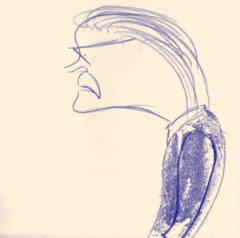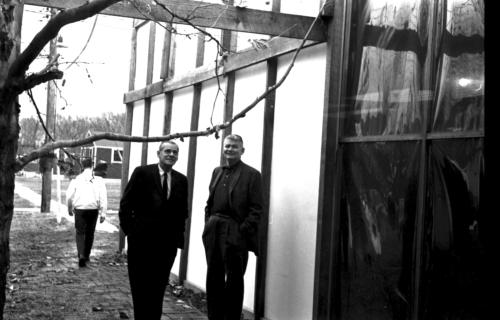Design at Southern Illinois University
In the fall of 1959 Davis Pratt, sat on the edge of his desk, on the second floor of the new library, and stroked his
chin. In a calm voice, he assigned our class an amazing project.
We were to go to Giant City State Park and either camp out or spend time creating a “primitive” society of people
who lived there:
•
What god or gods would they worship, and what effigy might they have devised?
•
What were their behavioral rules?
•
What crops would they grow or harvest from the wild?
•
What kind of shelters would they have built?
•
What tools or artifacts would they have devised?
•
What was the size and locale of their village?
Unable to get away to camp out, I did spend a day at Giant City, taking
notes, photographs and making sketches. I was going to make a humane
society, a god-like task. I vowed to avoid the usual clichés.
I worked at home rather than at school, because I had air conditioning,
and a complete set of drafting tools, pastels, airbrush, and classical music.
Besides, I had to keep an eye on our son and daughter while my wife
worked at the glove factory, and I was doing free-lance design and
illustration by mail.
The effigy for the god came first. I made a vertical clay slab and scooped a
round, concave moon in one side. On the back, the same shape was convex. Worship
in, forgiveness out, get it? The slab would be erected on one of the giant slabs of rock in the park that looked a bit
like an altar.
The rules would be novel too- monogamous marriages, with strict punishment for adulterers. Democratic
discussions in a large, thatch-roof enclosure where a head-man would be voted in or voted out. There would be
expulsion from the tribe for repeat offenders, but no death penalty.
Since the site was mostly woodlands, the tribe would be hunter-gatherers. I was never interested in farming, and
figured they might not be either.
There were no caves in the park large enough for shelter. I’d crawled through plenty of Illinois caves as an
Explorer Scout, and knew that was no way to live. So I decided there would be huts for each family. And a big one
for singing and meetings.
Of course, they would have flint knives, bows, arrows, spears, clubs and maybe slings, although I reasoned slings
would not be as effective in the woods as in the desert.
They would be about 300 people. After that, a new village would have to be started somewhere else, but not too
close.
The presentation day came. Most of my classmates were a few years younger, and had not spent much time on a
god. Instead, they made stools, models of housing, and tools. I leaned back, arms folded, deciding they had not
seen the big picture.
Davis Pratt was a thoughtful man of few words. Through
each presentation, he just nodded, and smiled.
For my presentation, I decided to mimic the then popular TV
program You Were There.
My totally innovative project would blow my classmates
away. I even imitated Walter Cronkite’s voice like on TV
when he interviewed Robert E. Lee at Gettysburg.
As I presented, I noticed Davis had stopped smiling. He had
begun to tap his lip with his index finger. He loves it, I
thought, as I displayed the religious slab. When I finished,
he nodded for probably for a full minute, but said nothing.
My classmates didn’t say much either. And some days later,
sitting in church, I realized why.
My effigy was an abstract image; sin in, forgiveness out. My
rules for behavior came from the Bible. The size of the
village was 300, about the size most churches reach before
they start a new mission. And Baptists hired and fired their
pastors.
What had Davis Pratt’s project, and more important, silence allowed me to realize was that my thinking was
conventional and very narrow. That realization was the beginning of a slow but irrevocable change in my life.
Suffice it to say, I consider Davis Pratt to be one of the greatest teachers I ever had.

Al Gowan - Cambridge, MA - a.gowan@comcast.net - (SIU Design 1953-55, and fall of 1959)
A Davis Pratt Tribute
by Al Gowan
by Bruce Lierman


photo by Dale Carlson - Davis Pratt in the middle



















